
Akseli Gallen-Kallela was a Finnish painter who is best known for his illustrations of the Kalevala, the Finnish national epic. His work is considered a very important aspect of the Finnish national identity. He finnicized his name from Gallén to Gallen-Kallela in 1907.

Kullervo is an ill-fated character in the Kalevala, the Finnish national epic compiled by Elias Lönnrot.

Lemminkäinen or Lemminki is a prominent figure in Finnish mythology. He is one of the heroes of the Kalevala, where his character is a composite of several separate heroes of oral poetry. He is usually depicted as young and good-looking, with wavy red hair.

Jorma Gallen-Kallela was a Finnish artist. He followed in the footsteps of his father, the famed artist Akseli Gallen-Kallela.

Aino is a figure in the Finnish national epic Kalevala.
Karelianism was a late 19th-century cultural phenomenon in the Grand Duchy of Finland and involved writers, painters, poets and sculptors. Since the publishing of the Finnish national epic Kalevala in 1835, compiled from Finnish and Karelian folk lore, culture spheres in Finland became increasingly curious about Karelian heritage and landscape. By the end of the 19th century Karelianism had become a major trend for many works of art and literature in Finland. In the movement Karelia was seen as a sort of refuge for the essence of "Finnishness" that had maintained its authenticity across centuries. The phenomenon can be interpreted as a Finnish version of European national romanticism.

Ateneum is an art museum in Helsinki, Finland and one of the three museums forming the Finnish National Gallery. It is located in the centre of Helsinki on the south side of Rautatientori square close to Helsinki Central railway station. It has the biggest collections of classical art in Finland. Before 1991 the Ateneum building also housed the Finnish Academy of Fine Arts and University of Art and Design Helsinki.
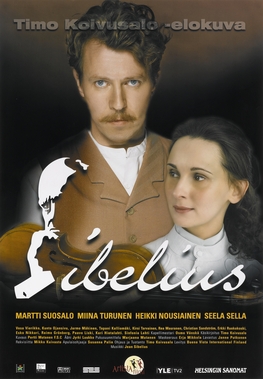
Sibelius is a 2003 Finnish film biography of Jean Sibelius directed and written by Timo Koivusalo. It is the first full-length feature film about the famous composer.
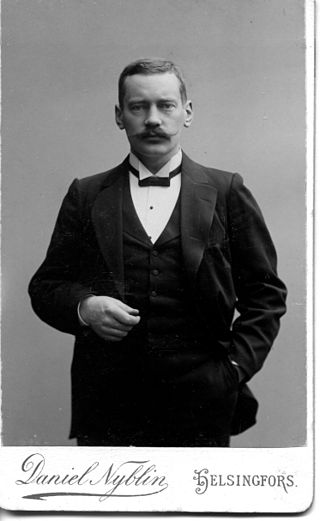
Adolf Georg Wiedersheim-Paul was a Swedish novelist and playwright. He lived most of his adult life in Berlin, Germany, where he was a friend of Swedish writer August Strindberg, Finnish composer Jean Sibelius, Norwegian painter Edvard Munch and Finnish artist Akseli Gallen-Kallela.

Pehr Louis Sparre af Söfdeborg was a Swedish painter, designer and draughtsman, most noted for his early work in the Finnish national romanticism and jugend styles. He also competed in the individual and team épée fencing events at the 1912 Summer Olympics.

The Garden of Death is a painting by Finnish symbolist painter Hugo Simberg. Like many of Simberg's paintings, it depicts a gloomy, otherworldly scene. The central figures are reminiscent of the classic black-clad Grim Reaper, but paradoxically are tending to gardens; traditionally symbols of birth or renewal.
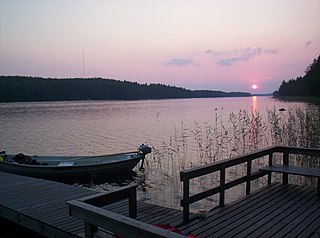
Keitele is a large lake located in Central Finland. With a area of 493.59 km2, it is the 9th largest lake in the country. The lake is divided into three regions, Ylä-, Keski-, and Ala-Keitele, of which Keski-Keitele is the largest. Water in the lake is clear and in excellent condition. The towns of Äänekoski and Viitasaari are located on the shores of Keitele.

The Old Student House is the former student house of the Student Union of the University of Helsinki, located in central Helsinki, Finland, near the crossing of Aleksanterinkatu and Mannerheimintie.
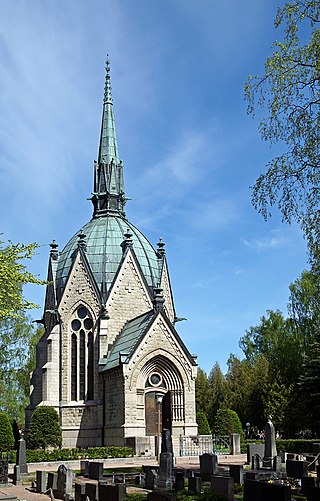
Jusélius Mausoleum is one of the most famous sights in Pori, Finland, at the Käppärä Cemetery. It is the only mausoleum in Finland and was completed in 1903.

Finnish art started to form its individual characteristics in the 19th century, when romantic nationalism began to rise in the autonomous Grand Duchy of Finland.

Saunassa is an 1889 oil painting by the Finnish artist Akseli Gallen-Kallela. It was painted in Ekola's croft in Keuruu. Gallen-Kallela gave his work to Knut Tilgmann, whose brother gave it to Ateneum in 1922. Gallen-Kallela did not like the picture and thought that it was unfinished.

Edith Helena von Bonsdorff was a Danish-Finnish ballet dancer and choreographer.

Parisian Backyard is an oil-on-canvas painting executed in 1884 by Finnish artist Akseli Gallen-Kallela. The work is 28 × 23 cm in size and belongs to the Ateneum, part of the Finnish National Gallery in Helsinki, where it was donated in 1945.

Kappeli, also known as Esplanadikappeli, is a restaurant in central Helsinki, Finland at the eastern end of the Esplanadi park, opened in 1867. The restaurant was known as a local favourite among poets, writers and artists during the late 19th and early 20th centuries. In August 2020 the building changed ownership from the city of Helsinki to HOK-Elanto, who currently also owns the restaurant itself.
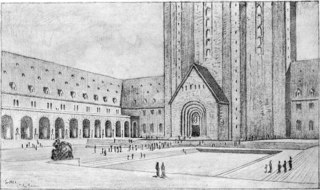
The Kalevala House was a proposed monumental building in Helsinki, Finland, intended to serve as the headquarters of the Kalevala Society and a center of Finnish culture. The plans included a Finnish cultural research institute, exhibition spaces, artists' workspaces and "research chambers". Additionally, the crypt beneath the foot of the 80-meter-high main tower was to serve as a burial place for notable Finnish figures and Fennomen. The building was to be located at the top of Munkkiniemi, near the present-day Hotel Kalastajatorppa.




















